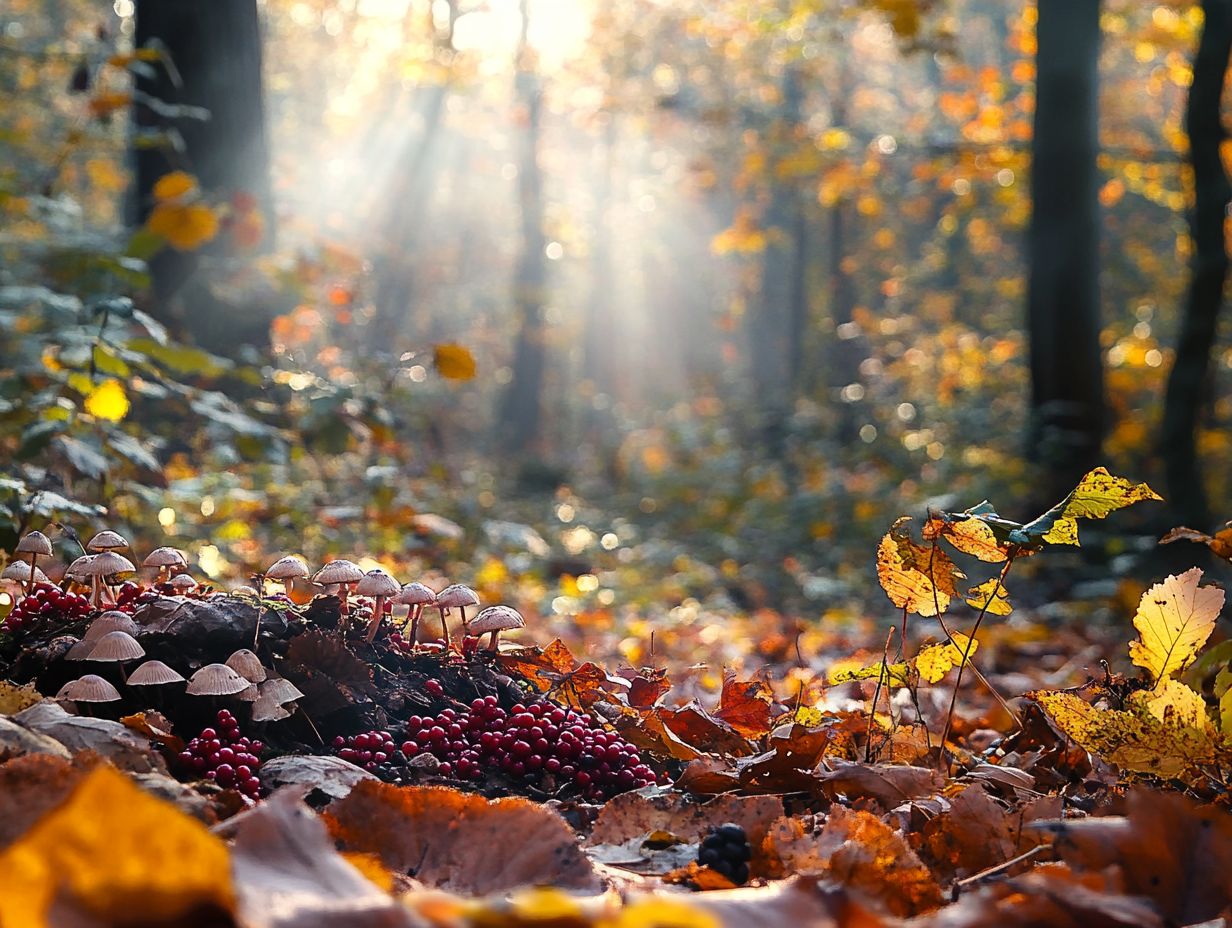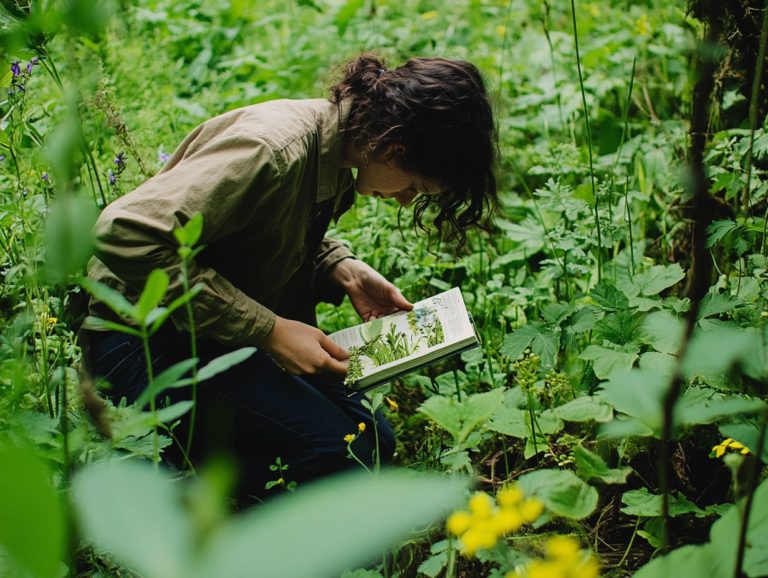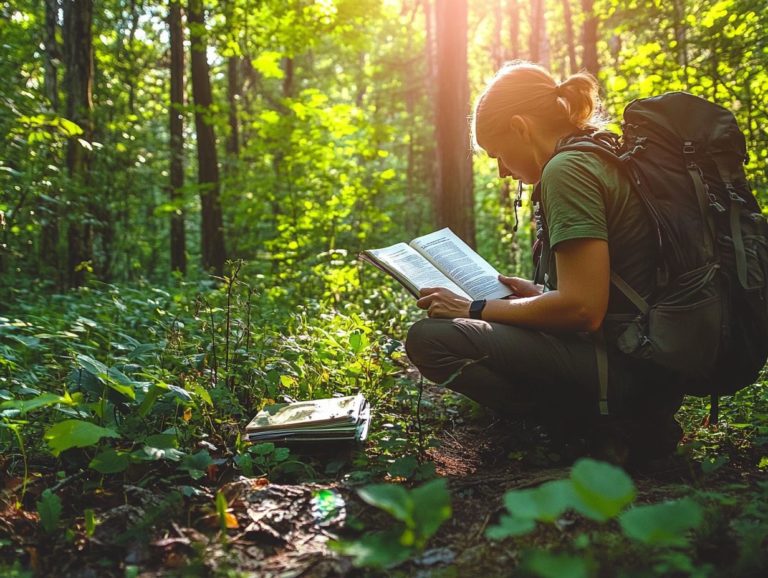How to Identify Wild Edibles During Fall
Dive into the rich world of autumn foraging and discover delicious treats waiting just for you! Foraging for wild edibles in the autumn opens up a world of rewarding adventure, allowing you to forge a unique connection with nature while discovering a bounty of nutritious foods.
As the leaves transform into a breathtaking tapestry of colors and the air becomes crisp, nature generously presents a variety of plants that are not just tasty but also brimming with health benefits.
Join us as we explore how to find safe, delicious plants you can enjoy this fall! This article will guide you through identifying safe and edible plants during this vibrant season, offer tips on how to prepare and cook them, and unveil their medicinal and culinary uses.
Whether you re a seasoned forager or just dipping your toes into this fascinating world, you’ll find valuable insights and enjoyable discoveries waiting for you.
Contents
Key Takeaways:

- Fall is the perfect time to forage for wild edibles, as they are abundant and offer high nutritional value.
- Learning to identify safe and edible plants is crucial before foraging. Look for common plants like tree nuts, wild grapes, rose hips, and mushrooms, and take necessary precautions for safety.
- Experiment with different methods for cleaning and cooking wild edibles, and consider their potential medicinal and cooking uses, especially with the addition of spicy flavors like sassafras.
What are Wild Edibles?
Wild edibles encompass a delightful array of plants and fungi that you can harvest from nature for your consumption. Think wild grapes, rose hips, and tree nuts like black walnuts and acorns.
These nutrient-rich treasures are typically foraged in backcountry areas during the fall season, when the crisp air invites you to explore the bounty of wild plants available. Foraging for these seasonal delights not only offers a chance to connect with nature but also proves vital for people who want to learn how to survive in the wild. By identifying edible plants in your region, you can enhance your nutrition with wild foods.
Embracing the art of foraging allows you to uncover the incredible diversity that nature has to offer. Beyond familiar flora, you ll discover lesser-known species like barberry and wintergreen that can elevate a simple meal into a vibrant, healthful experience.
Each wild edible boasts its own unique flavor profile and health benefits consider the antioxidant-rich dandelion greens, which are substances that help protect your body from damage, or the soothing qualities of chamomile flowers.
By incorporating these natural foods into your daily diet, you support your well-being and reduce reliance on commercially processed items, all while becoming more attuned to the rhythms of your local ecosystems.
The act of gathering food from the wild cultivates a deeper appreciation for the environment, fostering a sustainable approach to both eating and living.
Benefits of Foraging During Fall
Foraging in the fall season offers you a wealth of benefits, as the cooler weather and vibrant foliage create a perfect backdrop for harvesting a rich array of wild foods. To ensure a safe experience, it’s important to refer to resources like identifying safe edibles: a forager’s guide. You’ll find fruits, nuts, and herbs flourishing in the autumn air.
This time of year offers the pinnacle of foraging, with many edible plants reaching their peak nutritional value. It’s an enriching experience that appeals to nature enthusiasts alike, inviting you to connect deeply with the natural world while indulging in its bountiful offerings.
Nutritional Value and Seasonal Availability
The nutritional value of wild foods you discover in the fall can be truly remarkable. Many of these edible plants are brimming with vitamins, minerals, and antioxidants, making them a splendid addition to your diet. To maximize your foraging experience, learn how to identify wild edibles by region.
Take wild grapes, for instance; they’re not just a tasty snack, but also rich in vitamins C and K, perfect for enjoying fresh or turning into jellies and sauces that elevate your dishes. Then there are rose hips often overlooked but packed with vitamin C ideal for brewing into comforting teas or transforming into delightful jams that can brighten your breakfast table.
Don’t forget about persimmons, with their unique sweetness and high fiber content, which can add a seasonal flair to your salads or desserts. Additionally, knowing how to spot edible roots in the wild can enhance your culinary creations and serve as a reminder of the beauty of seasonal availability.
They inspire you to get creative in the kitchen while deepening your appreciation for nature s generous offerings. Get ready to explore your local area and uncover these hidden gems!
Identifying Safe and Edible Plants

Identifying safe and edible plants is essential for anyone venturing into foraging, as misidentification can pose serious health risks. By mastering plant identification techniques, you ensure you re selecting nutritious and flavorful options, like acorns and hickory nuts, while navigating the outdoors with confidence and avoiding potentially dangerous species.
Common Plants to Look For
When you’re foraging in the fall, delightful plants await your discovery, including sweet and tangy wild grapes, vibrant rose hips, flavorful sassafras, and nutrient-rich curly dock. For those interested in foraging, identifying edible plants in the Northeast can uncover a wonderful array of flavors and act as invaluable resources for foragers eager to tap into nature’s bounty.
Wild grapes typically flourish in wooded areas or along sunlit trails, showcased by their small, round clusters and tendril-bearing vines that make them easy to spot. Rose hips, often found in hedgerows, are the delightful fruits of wild roses, boasting a bright red hue and a tangy flavor rich in vitamin C. Sassafras, with its aromatic leaves and distinctive root, can be transformed into refreshing teas or even nostalgic root beer, while curly dock, with its broad, wavy leaves, offers edible seeds and nutritious greens that add a peppery flair to your salads.
Knowing where to look and how to spot edible plants in the wild can elevate your fall foraging adventure into an unforgettable experience.
Precautions and Safety Measures
Taking precautions and implementing safety measures while foraging is crucial for ensuring a successful experience in the wild. Understanding the dangers posed by poisonous plants is vital for your safety. Relying on reliable foraging guides significantly enhances your knowledge and confidence, making it easier to distinguish between safe and harmful varieties. Consulting with experienced foragers provides invaluable insights, further minimizing the risks associated with foraging.
Emphasizing the importance of thorough preparation and a cautious mindset helps you navigate unfamiliar environments safely, ensuring a rewarding and enjoyable adventure amidst the richness of nature’s bounty.
Preparing and Cooking Wild Edibles
Preparing and cooking wild edibles is an art that not only elevates flavors but also maximizes the nutritional benefits of foraged foods like wild grapes and black walnuts. Engaging in this process offers a truly rewarding culinary experience, transforming simple ingredients into extraordinary dishes.
Methods for Cleaning and Cooking

For wild edibles, mastering proper cleaning methods is critical for ensuring your safety and enhancing flavors. Picture rinsing wild grapes or peeling persimmons before you cook these small steps make a world of difference.
But don t stop at washing or peeling; exploring cooking techniques can truly elevate your experience with these ingredients. Consider saut ing wild mushrooms or steaming young nettles. Steaming preserves the vibrant green color and nutritional benefits of young nettles, while saut ing wild mushrooms brings out their earthy flavors and delicate textures.
Harnessing the natural sweetness of foraged berries through methods like softening or mixing with sugar can lead to exquisite sauces or toppings that delight your palate. By experimenting with different approaches, you not only appreciate the distinctive taste profiles of wild edibles but also cultivate a delightful array of dishes that celebrate nature s bounty.
Other Uses for Wild Edibles
Wild edibles serve as more than just a source of nutrition; they present a wealth of medicinal and culinary possibilities. Their versatility highlights their significance in traditional practices, enriching both your diet and your understanding of nature s bounty.
Medicinal and Culinary Applications
Wild edibles like chickweed help reduce swelling and wintergreen aids digestion. These plants not only heal but also elevate your meals with unique flavors and essential nutrients.
Take dandelion, for example. It’s celebrated for supporting liver health and its vibrant greens add a delightful kick to your salads.
Stinging nettle is packed with vitamin C. Toss it into soups to add nutrition and versatility to your dishes.
Herbal teas crafted from elderflower provide soothing relief for colds and allergies. They showcase the diverse benefits of wild edibles that go beyond just food.
Frequently Asked Questions
What are some tips for identifying wild edibles during fall?

To identify wild edibles in fall, know the types of plants in your area. Understanding their seasonal changes is crucial, and you can enhance your knowledge by using identifying wild edibles throughout the year guides or consulting experts.
What are some common wild edibles found in fall?
Look for mushrooms, nuts, berries, and greens like dandelion, lambsquarters, and purslane during fall foraging, and be sure to check out the basics of foraging to help identify edibles safely.
How can I tell if a mushroom is safe to eat?
Identify mushrooms using a field guide or expert advice. Check their color, texture, and smell, and look for identifying characteristics.
Are there dangerous look-alikes for edible plants?
Yes, some toxic mushrooms resemble edible ones. Always be 100% sure of a plant’s identity before consuming it.
What precautions should I take when foraging?
Wear appropriate clothing and footwear. Handle unfamiliar plants carefully and avoid areas that may be polluted.
Can I forage in any location?
Avoid foraging on private property or protected land without permission. Stay away from areas near roads or industrial sites to prevent contamination.






